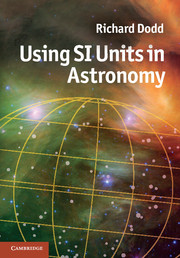Book contents
- Frontmatter
- Contents
- Preface
- Acknowledgements
- 1 Introduction
- 2 An introduction to SI units
- 3 Dimensional analysis
- 4 Unit of angular measure (radian)
- 5 Unit of time (second)
- 6 Unit of length (metre)
- 7 Unit of mass (kilogram)
- 8 Unit of luminous intensity (candela)
- 9 Unit of thermodynamic temperature (kelvin)
- 10 Unit of electric current (ampere)
- 11 Unit of amount of substance (mole)
- 12 Astronomical taxonomy
- References
- Index
Preface
Published online by Cambridge University Press: 05 December 2011
- Frontmatter
- Contents
- Preface
- Acknowledgements
- 1 Introduction
- 2 An introduction to SI units
- 3 Dimensional analysis
- 4 Unit of angular measure (radian)
- 5 Unit of time (second)
- 6 Unit of length (metre)
- 7 Unit of mass (kilogram)
- 8 Unit of luminous intensity (candela)
- 9 Unit of thermodynamic temperature (kelvin)
- 10 Unit of electric current (ampere)
- 11 Unit of amount of substance (mole)
- 12 Astronomical taxonomy
- References
- Index
Summary
Other than derogatory comments made by colleagues in university physics departments on the strange non-standard units that astronomers used, my first unpleasant experience involved the Catalog of Infrared Observations published by NASA (Gezari et al., 1993). In the introduction, a table is given of the 26 different flux units used in the original publications from which the catalogue was compiled – no attempt was made to unify the flux measures. The difficulties of many different ways of expressing absolute and apparent flux measures when trying to combine observations made in different parts of the electromagnetic spectrum became all too apparent to me when preparing a paper (Dodd, 2007) for a conference on standardizing photometric, spectrophotometric and polarimetric observations. This work involved plotting X-ray, ultraviolet, visible, infrared and radio frequency measurements of selected bright stars in the open cluster IC2391 as spectra with common abscissae and ordinates. Several participants at the conference asked if I could prepare a ‘credit card’ sized data sheet containing the conversion expressions I had derived. As is usually the case, I was otherwise engaged at the time in comparing my newly derived coarse spectrophotometry with a set of model stellar atmospheres, so the ‘credit card’ idea was not acted upon. However, the positive response to my paper did make me realize that there was a need in the astronomical community for a reference work which, at the least, converted all the common astronomical measurements to a standard set.
Information
- Type
- Chapter
- Information
- Using SI Units in Astronomy , pp. ix - xiPublisher: Cambridge University PressPrint publication year: 2011
